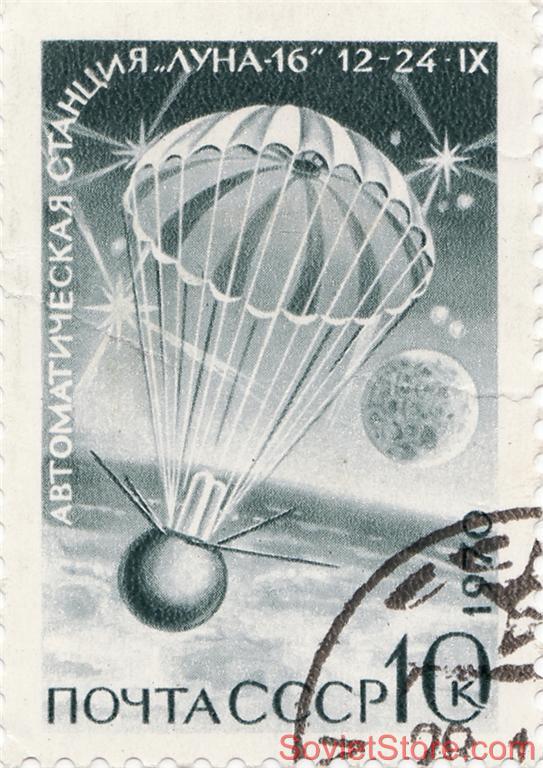SearchProduct Type
|
Add us to: Favorite Stores Item's weight: less then 1 g.
Stamp Authenticity Since 1939 till 1990 Lithuania suffered 3 occupations: 1 German (1941-1944) and 2 Soviet (1939-1941, 1944-1990), one of which lasted 46 years. In WWII occupations were based on violent battles between Germans and Russians. These historical events left a lot of stuff behind them selves. Almost every family in Lithuania has something left, related to USSR history in their forgotten drawers. So we are just traveling around lithuanian countrysides and collecting this memorabilia. Item is original, genuine, authentic, unique, not a copy or replica - has 2-12 decades of it's own unique history.
Luna 16 (Ye-8-5 series) was an unmanned space mission of the Luna program, also called Lunnik 16 (two n). Luna 16 was the first robotic probe to land on the Moon and return a sample to Earth.[1] It represented the first lunar sample return mission by the Soviet Union, and was the third lunar sample return mission overall, following the Apollo 11 and Apollo 12 missions. The spacecraft consisted of two attached stages, an ascent stage mounted on top of a descent stage. The descent stage was a cylindrical body with four protruding landing legs, fuel tanks, a landing radar, and a dual descent engine complex. A main descent engine was used to slow the craft until it reached a cutoff point which was determined by the onboard computer based on altitude and velocity. After cutoff a bank of lower thrust jets was used for the final landing. The descent stage also acted as a launch pad for the ascent stage. The ascent stage was a smaller cylinder with a rounded top. It carried a cylindrical hermetically sealed soil sample container inside a re-entry capsule. The spacecraft descent stage was equipped with a television camera, radiation and temperature monitors, telecommunications equipment, and an extendable arm with a drilling rig for the collection of a lunar soil sample. Mission profileThe Luna 16 automatic station was launched toward the Moon from a preliminary Earth orbit and after one mid-course correction on 13 September it entered a circular 111 km with 70° inclination lunar orbit on September 17, 1970.
The lunar gravity was studied from this orbit. After two orbital adjustments were performed on 18 September and 19 September the perilune was decreased to 15.1 km, as well as the inclination altered in preparation for landing. At perilune at 05:12 UT on 20 September, the main braking engine was fired, initiating the descent to the lunar surface. Six minutes later at 05:18 UT, the spacecraft safely soft-landed in its target area at 0°41' south latitude and 56°18' east longitude, in the northeast area of the Sea of Fertility, approximately 100 kilometers east of Webb crater. This was the first landing made in the lunar night side, as the Sun had set about 60 hours earlier. The main descent engine cut off at an altitude of 20 m and the landing jets cut off at 2 m height at a velocity less than 2.4 m/s, followed by vertical free-fall. The mass of the spacecraft at landing was 1,880 kilograms. Less than an hour after landing, at 06:03 UT, an automatic drill penetrated the lunar surface to collect a soil sample. After drilling for 7 minutes, the drill reached a stop at 35 centimeters depth and then withdrew its sample and lifted it in an arc to the top of the spacecraft, depositing the precious cargo in a small spherical capsule mounted on the main spacecraft bus. The column of regolith in the drill tube was then transferred to the soil sample container. Finally, after 26 hours and 25 minutes on the lunar surface at 07:43 UT on 21 September, the spacecraft's upper stage lifted off from the Moon. The lower stage of Luna 16 remained on the lunar surface and continued transmission of lunar temperature and radiation data. Three days later on 24 September, after a direct ascent traverse with no midcourse corrections, the capsule, with its 105 grams of lunar soil, reentered Earth's atmosphere at a velocity of 11 kilometers per second. The capsule parachuted down 80 kilometers southeast of the town of Dzhezkazgan in Kazakhstan at 05:25 UT on 24 September 1970. Analysis of the dark basalt material indicated a close resemblance to soil recovered by the American Apollo 12 mission. According to the Bochum Radio Space Observatory in the Federal Republic of Germany, strong and good quality television pictures were returned by the spacecraft. Luna 16 was a landmark success for the Soviets in their deep space exploration program; the mission accomplished the first fully automatic recovery of soil samples from the surface of any extraterrestrial body.
References
The free listing tool. List your items fast and easy and manage your active items. On Jul-02-08 at 07:19:30 PDT, seller added the following information:
| Return
Items must be returned within 30 days .
Refund will be given as Money back. Refund policy details: Return is accepted at any reason. Item(s) must arrive to us not later then 30 days after it was shipped out (you will be informed about this immediately after it will be done). Returned items must be the same item in the exact same condition as originally shipped. Refunds are for the final eBay item purchase price only, less a 10% restocking fee. Shipping costs, insurance, and handling charges (if any) are non refundable. Returns must be shipped insured. Shipping
Payment Method
Insurance
Not Offered (Domestic)
|
Shopping Cart |
|||||||||||||||||||||||||||||||||||||||||||||||||||||||||||||||||||||||||||||||||||||||||||||||||||||




